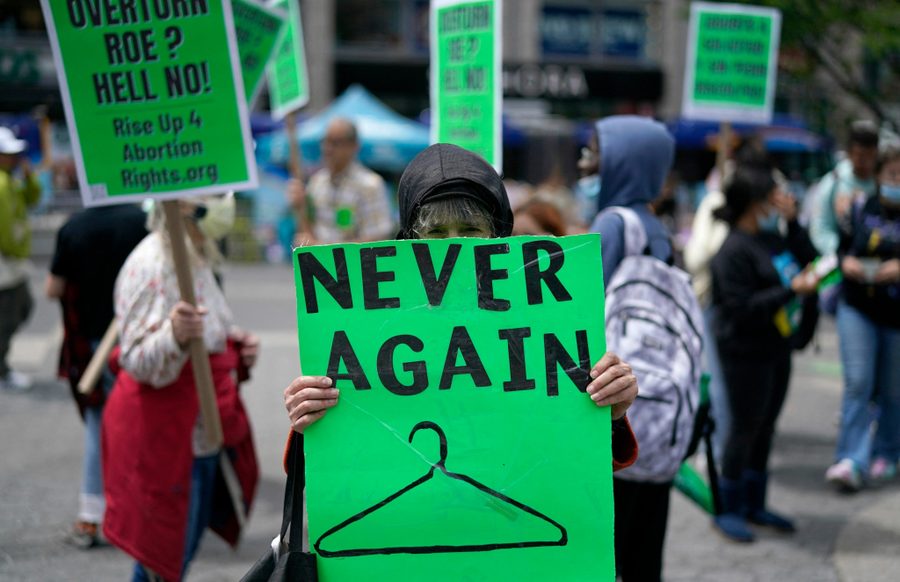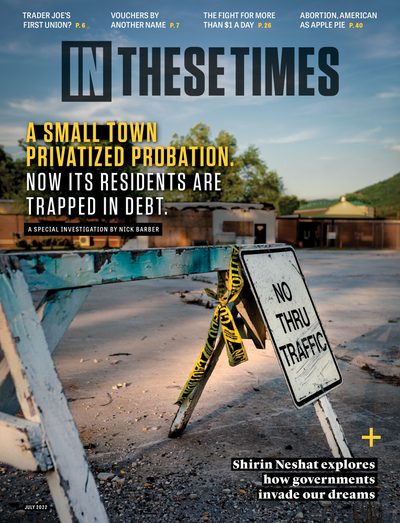
As the Supreme Court revisits a person’s constitutional right to end an early pregnancy, media outlets have been revisiting what an anti-abortion reality could look like in many states. In 1997, ITT writer and feminist journalist Debbie Nathan covered that ground with her review of Leslie J. Reagan’s book, When Abortion Was a Crime.
It turns out, the anti-abortion movement is relatively new. Abortion has been commonplace in the United States from Reconstruction on, a history that offers lessons in healthcare justice, bodily autonomy and dissent. A new preface has been added to Reagan’s book, which is out now through the University of California Press.
In 1997, Debbie Nathan wrote:
When we think of abortion before Roe vs. Wade, we usually conjure up scenes of do-it-yourself coat-hanger jobs ending in horrible infection or even death — or for women who could afford better, blindfolded trips to shady places with anonymous “doctors” who were really bartenders. In either case, we think of women terrified, mortified and prostrate in the face of the illegality of their act.
These are apt images for the ’60s, the ’50s and even the ’40s. But as historian Leslie Reagan demonstrates in When Abortion Was a Crime, to go back any further is to enter very different territory.
In a painstaking perusal of old newspapers, inquests into women’s deaths and the trial transcripts of accused abortionists, Reagan shows that the Christian right is dead wrong when it insists that abortion violates traditional American morality. As recently as the Depression era, women, their doctors and even prosecutors maintained surprisingly accepting attitudes toward an act that was forbidden by law and denounced by the medical profession.
Consider Chicago in the ’30s. In the heart of the Loop, practically next door to Marshall Field’s, was the Gabler abortion clinic. Each week it performed dozens of procedures in a facility whose equipment rivaled that of the best hospitals. Gabler attracted patients by distributing business cards to pharmacies and beauty shops. It also received referrals from the city’s most respected physicians.
Chicago was hardly unique. Across the country, reputable doctors did abortions even in the smallest towns. The practice was so open that in Newark, N.J., thrifty young women carried cards indicating they paid dues to a benevolent association that provided cheap abortions should the need arise.
The cards and the clinic were possible because of a popular morality at loggerheads with official pronouncements. For decades after abortion was outlawed in the United States in the late 19th century, women and their families retained a matter-of-fact stance toward it. Churches nominally opposed the practice, as did medical societies. Unlike today, though, religious organizations did not politick around the issue. Many established doctors performed abortions, and law-enforcement authorities looked the other way
Reagan begins her tale by reminding us that for centuries, Anglo-American law ignored abortion, eventually banning it only after “quickening,” the moment, well into the second trimester of pregnancy, when a woman first feels fetal movement. Traditionally, it was not doctors or ministers but women who determined the exact moment when life began. By 1867, however, newly professionalizing and mostly male doctors had helped to usurp feminine morality by pressuring the government to ban abortion from conception. Nonetheless, well into the ’20s, most women still felt they were doing nothing wrong when they aborted before quickening. The U.S. birth-control movement was loathe to admit it, but in the early 20th century, women, particularly wives with children, used abortion as a form of contraception.
If they could afford it, women had abortions with plenty of help, and not just from midwives, but also from reputable physicians. Reagan’s perusal of legal records demonstrates that many established doctors performed abortions in their offices and in patients’ homes, despite staunch opposition from organizations like the American Medical Association. This alliance between individual physicians and their women patients was possible because doctors still practiced in oneman offices and made house calls. In families, wives and mothers called the doctor and paid his bill. If a physician wanted to be asked back to treat the next illness, he had to get along with women. In trying to do so, many doctors came to empathize with their female patients’ need for abortion.
At the same time, other doctors toed their profession’s anti-abortion line. When women died from botched abortions, local medical societies helped prosecutors gather evidence — typically against midwives, but sometimes against physicians as well. Juries usually refused to convict these defendants; even so, the dead woman’s female friends and kin were forced into court to give intimate details about her body and sex life. Abortions in which the woman did not die— the vast majority— almost never led to prosecution. In any case, neither legal sanctions nor health risks had much effect on women’s decisions to end a pregnancy. With antibiotics still a decade away, women who could pay for professional help found that ending a pregnancy was scarcely more dangerous than delivering a baby at term.
Much of this changed during the Depression. Amid grinding poverty, women increasingly aborted themselves, and more and more ended up in the septic wards of the new urban hospitals. Many doctors in these institutions came to see abortion as a “therapeutic” treatment for the economic sufferings of mothers and families. Society at large mostly shared this judgment — thus the well-advertised clinics, the informal insurance policies, and police who looked the other way.
World War II to the early ’70s is the period we remember. Not coincidentally, Reagan reminds us, this is also when white women began entering the labor force in droves and many unmarried women began seeking abortions. In the past, most patients had been wives with families, and society pitied them as self-sacrificing mothers trying to make a better life for the children they already had. Now, bachelorette Rosie the Riveter was having abortions — and by implication sex — strictly for her own benefit.
Beginning in the ’40s, the medical profession and the government formed a virulent anti-abortion alliance. The police began raiding clinics and dragging patients into stations for pelvic exams. Doctors who had done abortions unmolested for years were arrested. Hospitals established committees to monopolize decision-making about who did and didn’t deserve an abortion. Only a very few affluent, and mostly white, women could afford the psychiatric scrutiny needed to certify them as worthy. Everyone else got the blindfolded rides, the terror and the humiliation — or, if they were poor, the often fatal do-it-yourself procedures.
This near-overnight transformation shouldn’t surprise us — not after what we’ve learned from work like Stephanie Coontz’s The Way We Never Were, which ought to be kept on the shelf right next to When Abortion Was a Crime. As Coontz shows, increasing female independence and changing gender roles sparked a perverse reaction in the ’50s that cosseted women in ways not seen since the Victorian era. In its wake, we got pronatalism, enforced housewifery, the feminine mystique and, as Reagan reminds us, McCarthyite paranoia that branded as communist anyone who supported abortion reform.
At the same time, middle-class wives continued to leave home to work, and single women put off marriage in order to pursue jobs and higher education. The postwar boom, with its seemingly endless demand for labor and its commercialization of traditional household tasks, practically required that women leave the home. Reagan doesn’t have much to say about these trends, but if you read her along with Coontz, it’s clear that the marketplace as well as ’60s feminism demanded that women control their own fertility.
Physicians, meanwhile, were changing their attitudes about abortion. Draconian suppression was once again bringing doctors face to face with abortion-related infection and death. Obstetricians and gynecologists grew increasingly offended at the denial of what they saw as their right to decide when an abortion was medically indicated. By 1968, the American College of Obstetricians and Gynecologists favored the liberalization of abortion laws. Psychiatrists, the new liberal wing of the medical profession, called for outright repeal. When doctors nationwide were polled the next year, most agreed.
Physicians did not make this shift on their own. They were steered toward it by the women’s movement, which advocated total repeal of the criminal abortion laws, based on a woman’s right to control her own reproductive life. The alliance between feminists and the medical profession is the crucial prehistory of Roe. Feminist lawyers were only successful in making their case when they framed it in terms of medical autonomy: They argued that doctors had a professional prerogative to decide when abortion was appropriate.
The legal importance of the woman-doctor alliance is tellingly illustrated by the wording of Roe vs. Wade. In its finding for the plaintiff, the Supreme Court rejected the argument that criminal abortion laws discriminated against poor women. But the judges did hold that in the first trimester of pregnancy, “the attending physician, in consultation with his patient, is free to determine, without regulation by the State, that, in his medical judgment, the patient’s pregnancy should be terminated.” Roe thus put abortion into physicians’ hands as well as women’s, and subjected the rights of the latter to technologically based measures of fetal “viability.“
Reagan worries that the bargain abortion-rights advocates struck with the medical profession may have been a Faustian one. Today, only 12 percent of ob-gyn residents are trained to do even a simple first-trimester abortion. Hospitals, meanwhile, are generally unwilling to house abortion facilities; this leaves abortion doctors ghettoized in freestanding clinics that are easy prey for Operation Rescuestyle harassment. More ominously, medical personnel have helped police charge drug- or alcohol-addicted pregnant women with “child abuse” of fetuses in utero. Given these trends, Reagan fears that if abortion were outlawed, women could be subjected to high-tech state and medical surveillance of their reproductive systems, including the ultrasounding of wombs after reports of miscarriage.
Even if abortion is never again outlawed in this country, there are important lessons to be drawn from Reagan’s history. Though doctors’ professional autonomy opens space for women to circumvent legal restrictions on abortion, doctors — even “in consultation with” their patients — shouldn’t dominate the discussion of reproductive rights and wrongs. Female equality simply cannot exist without legal, universally available abortion. But as long as that right is deemed merely a matter of privacy, countless women, such as those too poor to afford a doctor, will be left powerless to control their reproductive lives.








